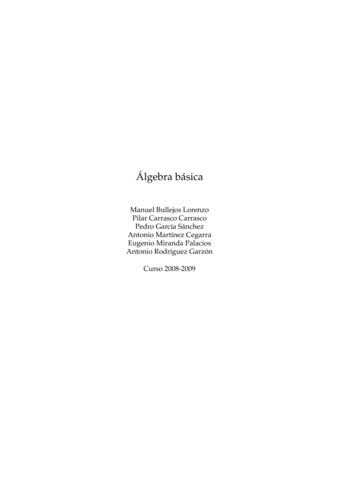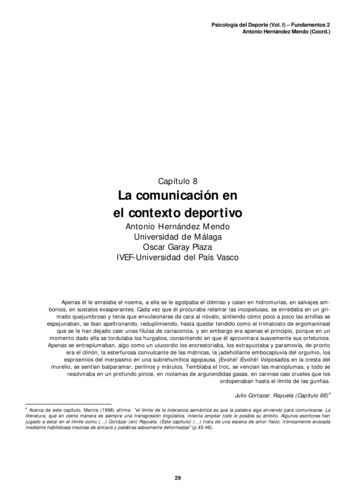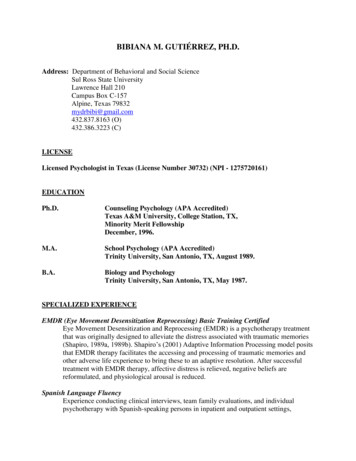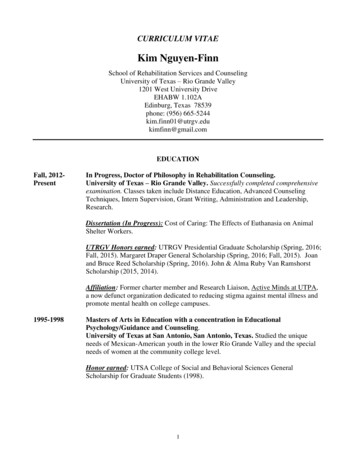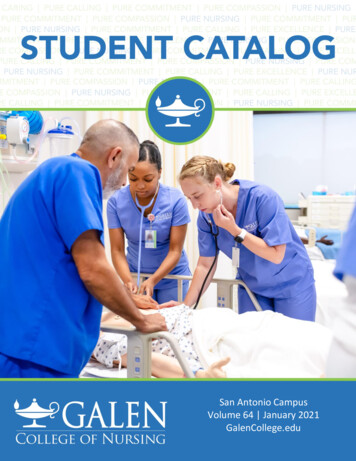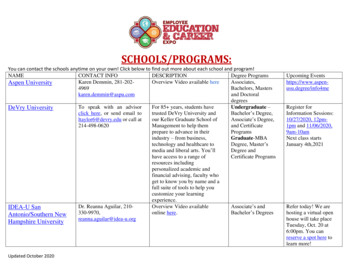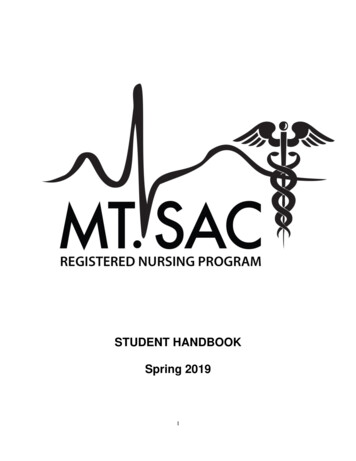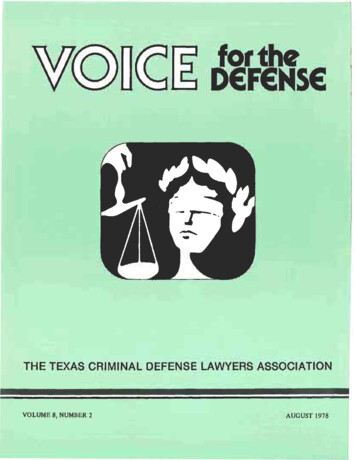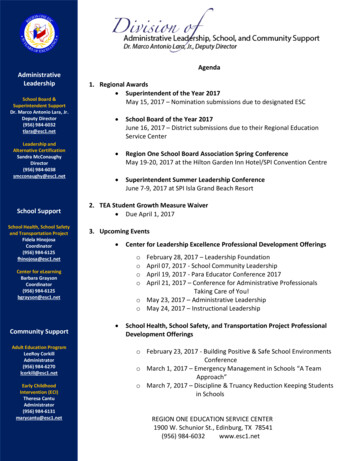
Transcription
AgendaAdministrativeLeadershipSchool Board &Superintendent SupportDr. Marco Antonio Lara, Jr.Deputy Director(956) 984-6032tlara@esc1.netLeadership andAlternative CertificationSandra McConaughyDirector(956) 984-6038smcconaughy@esc1.netSchool SupportSchool Health, School Safetyand Transportation ProjectFidela HinojosaCoordinator(956) 984-6125fhinojosa@esc1.net1. Regional Awards Superintendent of the Year 2017May 15, 2017 – Nomination submissions due to designated ESC School Board of the Year 2017June 16, 2017 – District submissions due to their Regional EducationService Center Region One School Board Association Spring ConferenceMay 19-20, 2017 at the Hilton Garden Inn Hotel/SPI Convention Centre Superintendent Summer Leadership ConferenceJune 7-9, 2017 at SPI Isla Grand Beach Resort2. TEA Student Growth Measure Waiver Due April 1, 20173. Upcoming Events ooooFebruary 28, 2017 – Leadership FoundationApril 07, 2017 - School Community LeadershipApril 19, 2017 - Para Educator Conference 2017April 21, 2017 – Conference for Administrative ProfessionalsTaking Care of You!o May 23, 2017 – Administrative Leadershipo May 24, 2017 – Instructional LeadershipCenter for eLearningBarbara GraysonCoordinator(956) 984-6125bgrayson@esc1.netCommunity SupportAdult Education ProgramLeeRoy CorkillAdministrator(956) 984-6270lcorkill@esc1.netEarly ChildhoodIntervention (ECI)Theresa CantuAdministrator(956) 984-6131marycantu@esc1.netCenter for Leadership Excellence Professional Development Offerings School Health, School Safety, and Transportation Project ProfessionalDevelopment Offeringso February 23, 2017 - Building Positive & Safe School EnvironmentsConferenceo March 1, 2017 – Emergency Management in Schools “A TeamApproach”o March 7, 2017 – Discipline & Truancy Reduction Keeping Studentsin SchoolsREGION ONE EDUCATION SERVICE CENTER1900 W. Schunior St., Edinburg, TX 78541(956) 984-6032www.esc1.net
2017 Superintendent of the YearDates to Remember May 15, 2017: Nomination submissions due to designated ESC June 30, 2017: Regional screening completed and nominations submitted to TASB August 25-26, 2017: All regional winners interviewed and five finalists chosen by the TASB State Selection Committee October 6, 2017 at Convention: Finalists interviewed and Superintendent of the Year chosen by TASB State SelectionCommittee October 7, 2017: Presentation of the award at 2017 TASA/ TASB ConventionEligibility & NominationsA local school board that is currently an “Active Member” of TASB may nominate its superintendent for the award. Entries must beeither postmarked by May 15, 2017, or delivered to the designated regional ESC by close of business that day.Nominees must have served as superintendent of the district since September 1, 2014; be a TASA member; be certified and meetthe State Board for Educator Certification continuing professional education requirement; and be an active superintendent at thetime of the 2016 TASA/TASB Convention.Superintendents who receive the top state award cannot be nominated again during the following five-year period. This rule doesnot apply to superintendents who were named regional winners or state finalists.Entry RequirementsPlease note that the process has been streamlined. Entries must be completed by the school board and signed by the school boardpresident. The letter of recommendation (no more than five pages) from the president must be submitted with a Resolutionindicating the board’s decision to nominate the superintendent. Please note that board action is required for the Resolution.Participating districts should place an item to cover this on their board meeting agendas. In the letter of recommendation, use 12point Times New Roman, 1.5-spacing, and 1-inch margins.The submission also must include the Official Entry Form, Student Performance Work Sheet, superintendent’s resume (no more thanthree pages), and photo on a separate page. Please be sure to list current positions and professional organizations first in thissection of the resume. Additional materials will not be accepted.Entries should be sent to the executive director of the district’s respective ESC. Entries must be either postmarked by Monday, May15, 2017, or delivered to the ESC by close of business that day. The Official Entry Form, Student Performance Work Sheet, andResolution are available for download on the TASB website at tasb.org/soty.Important NoteSOTY information is at your fingertips. The entry form and resolution for the SOTY award program can be downloaded fromtasb.org/soty. You will also find the following items: Cover letter Resolution Official entry form (revised) SOTY brochure Mission Statement/Explanation Student Performance Work Sheetpage for entry List of ESCsQuestions? Call the TASB Public Information Office at 800.580.8272 or e-mail barbara.williams@tasb.org.
2017 School Board of the YearDates to Remember June 16, 2017: District submissions due to their Regional Education Service Center July 17, 2017: Regional school board nominations due to TASA from ESCs August 8, 2017: TASA School Board Awards Committee announces five Texas Honor School Boards October 6, 2017: Texas Outstanding School Board named at TASA/TASB Convention in DallasNominations & CriteriaSchool boards nominated for the 2017 awards must be serving during the 2016-17 school year. Board membershonored will be those who were serving when nominations were submitted.Any Texas superintendent of schools who is a member of TASA and who has been serving in his/her currentposition since July 1, 2015, other than the TASA president at the time the awards will be made, may nominatehis/her board of trustees by collecting and submitting data supportive of the criteria. Only members of TASA shall serve on the selection committees. No member of a selection committee shall be from a school whose board is being considered. No board may repeat as an Outstanding Board or Honor Board more often than once every five years(e.g., a board named as the Outstanding Board or as an Honor Board in 2013 or later is not eligible to benominated in 2017). Board members honored will be those who were serving when nominations were submitted to theregional education service centersRequired DocumentationSubmitted materials shall adhere to the following guidelines to make the contest competitive to all districts: Entries are limited to one binder, folder, or notebook with 8.5-x-11-inch pages. Oversized materials will berejected at the regional level. Total number of pages must not exceed 60, excluding title pages and section dividers. Each page thatcontains information counts as one page; e.g., if information is included on both sides of a sheet, twopages are counted. Biographical information, including photo if desired, shall be limited to not more thanone-half page per board member. Publication samples, such as newsletters, and documentary evidenceshall count as only one page if attached to a page or inserted in a sleeve within the submitted entry. Entries should be divided into 10 sections — one for each corresponding criterion — in the order that thecriteria are stated below. Audiovisual materials, such as slides or video presentations, will not be accepted.Important NoteComplete criteria and procedures can be found at www.tasanet.org.Questions? Contact Amy Francisco, Director, Communications and Media Relations, at afrancisco@tasanet.org,Texas Association of School Administrators
Measures of Student GrowthOverviewBeginning in the 2017-2018 school year, appraisal systems in Texas, whether the state-recommendedsystem or a locally developed system, will need to include a measure of student growth at the individualteacher level.What is Student Growth?Student growth measures how much a student progresses academically during his or her time with aparticular teacher. It takes into consideration a student’s entering skill level when measuring how muchthe student grew over time, and, as opposed to measuring student proficiency on an assessment,student growth isn’t concerned with whether or not a student passes a particular test or reaches apredetermined and uniform benchmark. It considers equally students who enter behind grade level, ongrade level, and beyond grade level, tailoring growth expectations to each student’s context.By measuring growth, a teacher develops a better understanding about the academic impact of his orher instructional choices. In a formative appraisal process like T-TESS, feedback derived from studentgrowth acts as a complimentary piece to the feedback derived from the appraisal rubric. Whereas therubric captures how the teacher’s practice impacts students holistically, student growth captures howthe teacher’s practice impacts students academically.How Should Student Growth Data Be Used?Student growth data should be used just as observation data and goal-setting and professionaldevelopment data are used in T-TESS – as feedback that will help inform teachers about what worked,what didn’t work, and what they can do to improve their practice moving forward.Student growth is one measure in a multiple-measure evaluation system, and the inclusion of studentgrowth data in a formative evaluation process provides for a more complete understanding of theimpact of instructional and professional practices teachers deploy over the course of a school year.What Are the Four Options for Measuring Student Growth?Districts have four options for measuring student growth: 1) student learning objectives (SLOs); 2)portfolios; 3) district-level pre- and post-tests; and 4) value-add measures (VAM) for teachers in statetested subjects.Districts are free to choose any measure for their teachers – no single measure must be used for aparticular grade or subject (e.g., VAM doesn’t have to be used for teachers of tested grades andsubjects). Districts can also use different measures for different grades or subjects. For example, a1TEA Student Growth Overview — January 2016
district could use SLOs for elementary generalists, but portfolios for secondary foreign languageteachers.Measures of Student GrowthThe four measures of student growth can generally be placed into two buckets. Process-based Student Growth Measures: SLOs and PortfoliosAssessment-based Student Growth Measures: District Pre- and Post-Tests and VAMSLOs and Portfolios:The SLO and Portfolio processes follow very similar paths. They are designed to engage teachers indeliberate thinking as they answer fundamental questions about their instructional plans and decisions.1.2.3.4.What are the foundational skills that I teach in this class?Where do I think my students will be with these skills upon entering my course?Where are my students actually with these skills upon entering my course?Based on where my students are with these skills, if I provide effective instruction throughoutthe course, where should these students be at the end of the course?With these growth targets set (in answering question 4), the teacher then monitors students’ progressthroughout the course to ensure that the instructional plans for those students are effectively movingthem toward their targeted skill level, making adjustments to pedagogy when necessary.In both SLOs and Portfolios, the teacher’s rating would come from both how well the teacher interactedwith the process and how well students reached and/or exceeded growth targets.SLOs and Portfolios are not about precisely quantifying or calculating an amount of growth. They aredesigned to guide deliberate and thoughtful decision-making for teachers and determine the impact oftheir instruction. The benefits and challenges of SLOs and Portfolios lie in the depth with which theyprompt strategic instruction and reflection. While this can be difficult and sometimes uncomfortable, itcan also be extremely valuable in improving pedagogy.District Pre- and Post-Tests and VAM:District Pre- and Post-Tests and VAM are student growth measures that focus on assessments as thebasis for determining students’ skill levels entering a course and exiting a course. They are designed toquantify growth at the individual student and/or teacher level.VAM uses standardized state assessments to determine whether or not a student progresses as much asexpected based on the student’s unique profile based on his or her prior state assessment results. VAMresults can be broken down into entering achievement levels (high, medium, and low), gender, socioeconomic status, and other student subcategories. VAM can show teachers what types of students are2TEA Student Growth Overview — January 2016
or aren’t progressing in their classes so that teachers can target professional development opportunitiesto improving instruction for those groups.Because VAM measures growth using state assessments, VAM can only be used for teachers in testedgrades and subjects. Any district choosing to use VAM as a measure of student growth will need to useat least one other measure for the approximately 80% of teachers that can’t use VAM.District Pre- and Post-Tests, like VAM, use assessments to determine entering and exiting skill levels forstudents, but they are based on district-level assessments instead of state assessments. Districts wouldbe free to decide whether to use district-created assessments or assessments secured from a thirdparty. The level of formative feedback and data analysis available with District Pre- and Post-Testswould be dependent on how the district collects, disaggregates, and shares student results withteachers.District Pre- and Post-Tests and VAM allow for greater comparability across campuses – students aretaking the same assessments and the interpretation of assessment results are generally objective andmathematical. The challenges with District Pre- and Post-Tests and VAM lie with the value of thefeedback in improving instruction. Knowing how much a student or a group of students grew over timedoesn’t necessarily indicate which actual instructional practices either lead to or hindered that growth.Training for Student Growth MeasuresSLOs and PortfoliosTEA will have a one-day training for appraisers and support teams on SLOs and Portfolios for thosedistricts that use these measures. The training will be provided through the regional education servicecenters (ESCs) and will be at no cost to the district for the 2017-2018 school year.District Pre- and Post-Test and VAMAlthough TEA will not have training for District Pre- and Post-Tests and Value-Added, districts thatchoose to use these measures are strongly encouraged to seek out training and guidance (TEA willprovide guidance documents) on how best to use these two measures in a formative appraisal processso that the data has instructional value for educators as teachers seek to improve their practices.Pilot/Refinement OpportunitiesVAMThrough the T-TESS pilot and refinement years (the 2014-2015 and 2015-2016 school years), districtshave been piloting VAM, looking at the campus and teacher-level data for informational purposes.Although it is uncertain at this point whether TEA will be able to continue the VAM pilot in the 20162017 school year, districts that plan to use VAM in the 2017-2018 school year and beyond should planon producing and funding that measure on their own.3TEA Student Growth Overview — January 2016
SLOsTEA is piloting an SLO process during the 2015-2016 school year. An SLO refinement year will occurduring the 2016-2017 school, where TEA will implement a refined SLO training and process based onfeedback and lessons learned from current pilot districts.Any district that is considering or wants to experience SLOs prior to the 2017-2018 school year isencouraged to participate in the SLO refinement year during the 2016-2017 school year. Districts canparticipate in a limited capacity, with just a single campus or a few grades and subjects taking part in theSLO refinement year. This experience will better position districts to both determine whether or notSLOs are a measure of student growth they’d like to use and understand what district-wideimplementation would entail heading into the 2017-2018 school year.Summary of Pros and Cons of the Student Growth MeasuresSLOs and PortfoliosProsMore granular feedback about whichinstructional choices were effective andineffectiveRatings based on a balance between teacherbehaviors and student outcomesTeacher-driven processesDistrict Pre- and Post-Tests and VAMProsLess campus-level support required forimplementationResults more objective, quantifiable, andcomparable between campuses4ConsSubjectivity and estimation throughout theprocessResults not practicably comparable betweencampusesRequires more campus-level support toimplementConsFeedback less insightful at the instructional levelRatings based on assessment results (don’tinclude teacher behaviors)Assessment-driven processTEA Student Growth Overview — January 2016
YEAR 2Student Learning ObjectiveThinking MapYEAR 1Before school beginsBefore school beginsFind TEKS thatalign toselectedcontentConsulthistorical datato narrowselection, ifneededWho are mystudents?Describetypicalstudents –Initial SkillProfileSelect class orclassesCollect dataabout studentsto identifycurrent level oflearningMap currentstudents to ISPWhat are myexpectationsfor thesestudents?DevelopTargeted SkillProfile todescribeexpectationsReviewsupplementaldata for eachstudentcovered in SLOEstablish atarget for eachstudentcovered in SLOIdentifyevidencesources todeterminegrowthHow will Iguide thesestudentstowardgrowth?Describe planfordifferentiationIdentifystrategies tomonitorprogressPlan forconferencingwithcolleaguesReview SLOplan withappraiser forapprovalMonitorprogressMeet withcolleagues toplaninstructionAdjustinstruction tomeet theneeds ofstudentsConferencewith appraiserat the midpointDecide generalcontent areafor focusWeeks 3-6Weeks 1-3Identify mostimportantcontent incourseWhat is thefocus for mySLO?Weeks 3-6Weeks 6-9Week 6 to nearend of courseWeek 9 to nearend of courseAre studentsprogressingtowardtargets?Near endof courseNear endof courseDid studentsgrow andwhat did Ilearn from theprocess?Collectevidence ofstudentgrowthRecord studentoutcomes ongrowth trackerReview studentprogress/consider areasto refinepracticeMeet withappraiser todiscussoutcomesImproved studentlearning and teacherpractice
SLO Rating RubricDistinguished(5)All or most of the following have been accomplished: Teacher has crafted a high quality SLO (above level three on the Quality Tool) Teacher has set student growth goals that reflect high expectations for students Teacher has consistently monitored student progress, collected data, reflected on hisor her pedagogy, and made successful adjustments to strategies, as needed All or almost all students demonstrated targeted growth Most students exceeded targeted growthAccomplished(4)All or most of the following have been accomplished: Teacher has crafted a quality SLO (above level two on the Quality Tool) Teacher has set student growth goals that reflect high expectations for students Teacher has monitored student progress, collected data, reflected on his or herpedagogy, and made adjustments to strategies, as needed Most students demonstrated targeted growth Some students exceeded targeted growthProficient(3)All or most of the following have been accomplished: Teacher has crafted a quality SLO (above level two on the Quality Tool) Teacher has set student growth goals that reflect high expectations for students Teacher has monitored student progress, collected data, reflected on his or herpedagogy, and made some adjustments to strategies Most students demonstrated targeted growthDeveloping(2)All or most of the following have been accomplished: Teacher has crafted an adequate SLO (level two on the Quality Tool) Teacher has set student growth goals that reflect adequate expectations for students Teacher has attempted to monitor student progress, collect data, reflect on his or herpedagogy, and make some adjustments to strategies, although with limited success Some students demonstrated targeted growthImprovementNeeded(1)Few or none of the following have been accomplished: Teacher has crafted an adequate SLO (level two on the Quality Tool) Teacher has set student growth goals that reflect adequate expectations for students Teacher has attempted to monitor student progress, collect data, reflect on his or herpedagogy, and make some adjustments to strategies, although with limited success Some students demonstrated targeted growthAppraiser Comments:Appraiser Signature:Date:Teacher SignatureDate:The table below provides guidance for locating evidence to support evaluation of teachers’ effectiveness on the criteria included in the rubric.Rubric CriteriaSupporting evidence locationQuality of an SLOReview of the SLO using the SLO Quality ToolExpectations for studentsSteps 4 and 5 on the template and the Student Growth TrackerStudents meeting targeted growthCompleted Student Growth Tracker at the end of the SLO interval
Connections between Student Learning Objectives (SLOs) andDimensions of the Texas Teacher Evaluation and Support System (T-TESS) RubricDimensionConnection to SLOsSLOComponentDimension inChapter 149PLANNING1.1 Standards and AlignmentThe teacher designed clear, well-organized, sequential lessons thatreflect best practice, align with standards and are appropriate fordiverse learners.Teachers demonstrate their content knowledge in selectingfocus standards and in selecting an approach for deliveringinstructions of those standards.Phase 1:Standardsaligned SLOStatement1B1.2 Data and AssessmentThe teacher uses formal and informal methods to measure studentprogress, then manages and analyzes student data to inform instruction.Teachers learn to analyze data and use formative assessmentsto monitor each student’s growth and adjust plans for studentinstruction and growth.Phase 1:StudentStartingLevel5C1.3 Knowledge of StudentsThrough knowledge of students and proven practices, the teacherensures high levels of learning, social-emotional development andachievement for all students.Teachers consider students’ abilities and experiences andconsult multiple data sources to determine the bestinstructional approach to address student needs.Phase 1:StudentStartingLevel2A1.4 ActivitiesThe teacher plans engaging, flexible lessons that encourage higher-orderthinking, persistence and achievement.Teachers consider the character of the discipline and howstudents can apply it to new situations in planning the contentand instructional activity.Phase 1:InstructionalPlan3EINSTRUCTION2.1 Achieving ExpectationsThe teacher supports all learners in their pursuit of high levels ofacademic and social-emotional success.The instructional strategies analysis and selections made by theteacher in the SLO process helps teacher differentiate and elicita good outcome for every student.Phase 1:InstructionalPlan3D2.2 Content Knowledge and ExpertiseThe teacher uses content and pedagogical expertise to design andexecute lessons aligned with state standards, related content andstudent needs.The SLO planning process for teachers is grounded in the subjectmatter/discipline and content-specific pedagogy, includingopportunity for deeper learning and college and careerreadiness.Phase 1:Standardaligned SLOStatement3A2.3 CommunicationThe teacher clearly and accurately communicates to supportpersistence, deeper learning and effective effort.Teachers share SLO expectations for their learning withstudents; teachers also communicate closely during learningexperience to engage students in their learning.Phase 2:ProgressCheck-ins5B2.4 DifferentiationThe teacher differentiates instruction, aligning methods and techniquesto diverse student needs.Teachers adjust their instruction based on student input andformative assessment throughout the entire SLO process.Phase 2:ProgressCheck-ins1C
DimensionConnection to SLOs2.5 Monitor and AdjustThe teacher formally and informally collects, analyzes and uses studentprogress data and makes needed lesson adjustments.Teachers give consideration to all types of student assessmentand feedback for use in developing and implementing andadjusting instruction.SLOComponentDimension inChapter 149Phase 2:ProgressCheck-ins1FLEARNING ENVIRONMENT3.1 Classroom Environment, Routines and ProceduresThe teacher organizes a safe, accessible and efficient classroom.Teachers identify instructional strategies, selecting evidencebased activities and using all available resources to maximizelearning.Phase 2:Instruction4B3.2 Managing Student BehaviorThe teacher establishes, communicates and maintains clearexpectations for student behavior.Teachers manage student behavior in order to maximize thetime spent learning the content.Phase 2:Instruction4C3.3 Classroom CultureThe teacher leads a mutually respectful and collaborative class ofactively engaged learners.Teachers create an environment of respect and rapport toeffectively convey the learning content and immerse students inthe learning content.Phase 2:Instruction4APROFESSIONAL PRACTICES AND RESPONSIBILITIES4.1 Professional Demeanor and EthicsThe teacher meets district expectations for attendance, professionalappearance, decorum, procedural, ethical, legal and statutoryresponsibilities.Teachers complete each phase of the SLO process with integrityand fidelity, meeting deadlines and providing all documentationas requested.Entire SLOprocess6D4.2 Goal SettingThe teacher reflects on his/her practice.The process encourages teachers to plan instruction withdeliberation and to set growth targets and monitor eachstudent’s growth. Reflection is encouraged at all stages and isthe basis of immediate changes and opportunity for professionallearning.Phase 2:ProgressCheck-ins;Phase 3:Reflection6A4.3 Professional DevelopmentThe teacher enhances the professional community.The SLO process flourishes in collaborative settings. Data, bestpractice, reflection, and new learning are the hallmarks ofteacher work.Phase 2:ProgressCheck-ins6B4.4 School Community InvolvementThe teacher demonstrates leadership with students, colleagues, andcommunity members in the school, district and community througheffective communication and outreach.SLO initiatives include teachers and community members fromthe beginning. From this experience, expand their learning circleand their sphere of influence.Entire SLOprocess6C
Connections between Student Learning Objectives and the Indicators of the Texas PrincipalEvaluation and Support System (T-PESS) ulingStrategicallyAppraiser ActionsT-PESSRubricEstablishes thorough SLO structures which streamline SLO processes forteachers including explicit plans for all of the following: Initial orientation and ongoing training Submissions Administrative reviews and conferences Modifications Approvals Completion and results analysis Communication and updates Progress monitoring Ongoing support3c, 3d, 5aAdjusts the master schedule: Considers SLO implications when revising the master schedule5bAlignmentand ToneSettingCollaborates with teachers to ensure that teachers’ SLOs reflect the following: Consistency with school and district priorities and goals Consistency with school vision, mission, and beliefs Consistency with campus improvement plan High expectations for teachers and students Clear descriptions of skill levels included in the Skill Profile1a, 2d, 3c,4aTraining ofStaffTrains staff in the state- and district-established SLO processes ensuring thefollowing: All affected teachers are trained District decisions are conveyed Tone is supportive Content delivered is accurate Understanding of participants is strong School-specific structures are communicated Expectations are set for high quality SLOs Communication is clear Support needs are assessed and addressed Questions are answered or directed to districts, ESC, or TEA asappropriate2a, 2b, 2c,2d, 3c,4d, 5cTopic(s)UsingEffectiveStructuresAppraiser ActionsThe following is evident from SLO planning documents: Structures are appropriately flexible and adaptable Procedures to develop and seek approval of SLOs are clearThe following is evident for SLO development and submission:Page 1T-PESS1d, 2a, 2b,2c, 2d, 3a,3c, 3d, 4b,4d
Provides clarity for due dates and location of resourcesEnforces due datesPlans time for teachers, peers and appraisers to develop their SLOsThe following is evident for review of and conferencing around SLO drafts: Responds in a timely manner Evaluates critical content Involves lead teachers and administrators with consistent reviews Provides appropriately informative responses Sets high expectations Holds conferences that are clear in format and purpose Maintains an atmosphere that supports teacher growth anddevelopment Is transparent in reflection on SLO design Uses SLOs as entry points for improving practiceThe following is evident for requests for SLO modifications: Process for making changes to SLOs is clear Process for resubmitting SLOs is clear Rationale for requesting changes is strong and clearThe following is evident for final SLO approvals: Approvals are timely Notification is clear when approved (who, ystemsChangeTopic(s)Ensures teachers are developing SLO elements and goals reflecting thefollowing: Attainability Consistency with district and school goals Data-informed rationale High expectations1a, 1b, 1c,1d, 2d, 4a,5aMaximizes time and builds capacity through the following: Enlisting lead teachers/ administrators in SLO processing whileinvolving himself/herself as well Analyzing data for SLOs to determine teacher and student needs Providing professional development to assist in SLO preparation Organizing needed support for SLO development1c, 2b, 2cPromotes continuous improvement through the following:
August 8, 2017: TASA School Board Awards Committee announces five Texas Honor School Boards October 6, 2017: Texas Outstanding School Board named at TASA/TASB Convention in Dallas Nominations & Criteria School boards nominated for the 2017 awards must be serving durin



